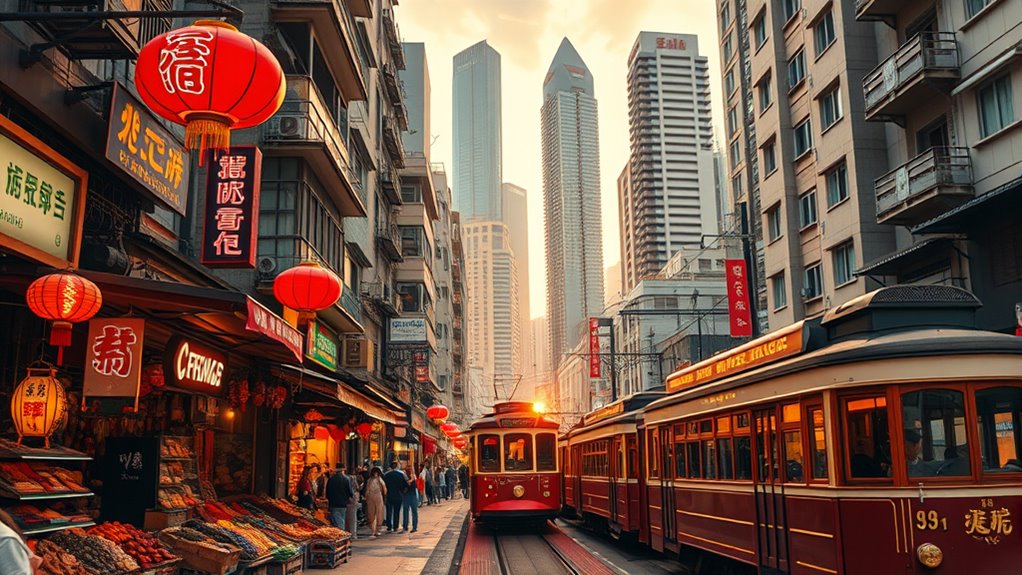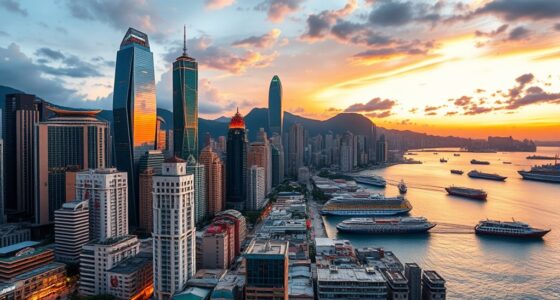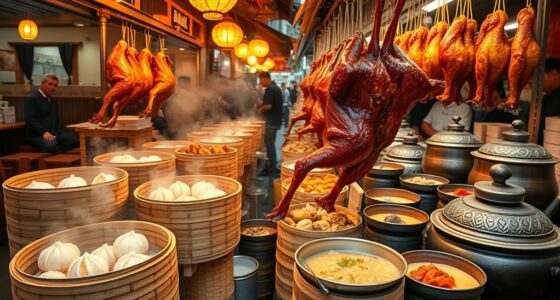Hong Kong’s history begins with prehistoric settlements and a blend of Chinese traditions and international trade. It was colonized by Britain in the 19th century, transforming into a global finance hub. During World War II, Japan occupied the territory, causing hardship. After the 1997 handover to China, it became a Special Administrative Region, balancing eastern and western influences. Its vibrant culture reflects resilience through centuries of change—keep exploring to discover more about this unique city’s rich heritage.
Key Takeaways
- Hong Kong’s history spans from prehistoric settlements and Chinese imperial rule to British colonial era and its 1997 handover to China.
- The region has a rich cultural blend of Chinese traditions and Western influences from colonial and international trade history.
- Colonial development introduced legal, educational, and infrastructural systems that shaped modern Hong Kong’s urban landscape.
- The city’s cultural identity is characterized by festivals, art, and social practices that merge Chinese heritage with cosmopolitan trends.
- Contemporary challenges include balancing political autonomy, preserving cultural heritage, and maintaining social stability amid ongoing tensions.
Early Foundations and Pre-Colonial Roots

Hong Kong’s early history stretches back to the Old Stone Age, with archaeological finds revealing prehistoric human activity in the region. You can see evidence of early settlers through ancient tools and artifacts discovered in caves and coastal sites. Initially, the area was part of the Chinese empire and was loosely incorporated into the Qin dynasty around 221 BC. Small coastal villages thrived by farming, fishing, and salt production, forming the foundation of local life. By the 16th century, foreign traders, such as the Portuguese, began establishing trading posts, marking the start of Hong Kong’s long history as a hub for commerce. During the Qing dynasty, the region was divided into counties like Bao’an and Xin’an, setting the stage for future development.
The British Colonial Period and Its Impact
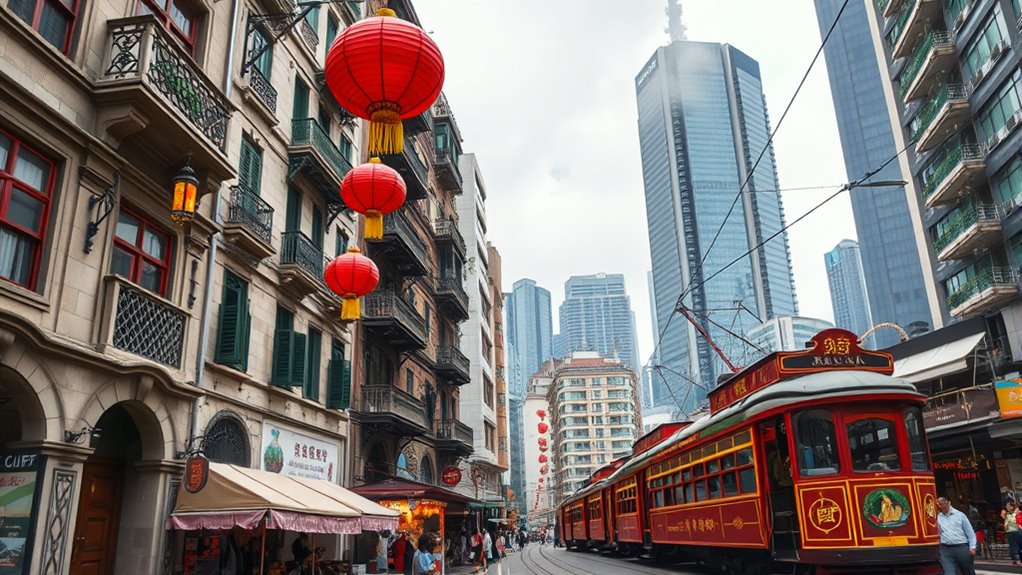
The British colonial period profoundly shaped Hong Kong’s development, transforming it from a small fishing and trading outpost into a major international financial hub. When Britain took control in 1841, you saw the establishment of key infrastructure like ports, roads, and legal systems. The treaties of 1842 and 1860 expanded the territory, attracting migrants and boosting trade. You experienced rapid urban growth, with industries like manufacturing and shipping flourishing in the mid-20th century. British governance introduced Western legal principles, education systems, and administrative practices that still influence Hong Kong today. The colonial period laid the foundation for Hong Kong’s reputation as a global financial center, blending Western institutions with local Chinese culture, shaping its unique identity and economic resilience well into the modern era. Additionally, the era saw the development of port facilities, which were crucial in establishing Hong Kong’s position as a key logistics and trade hub in Asia.
The Turbulent Era of World War II and Japanese Control
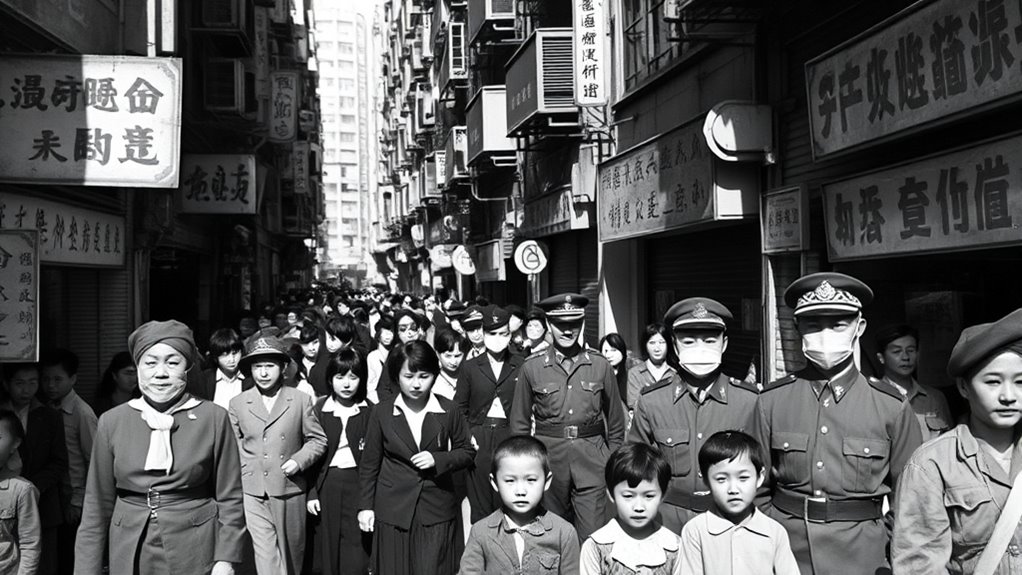
During World War II, Japanese forces seized control of Hong Kong in December 1941, marking a period of intense hardship for its residents. You would have experienced shortages, fear, and uncertainty as the occupation disrupted daily life. The occupation saw harsh military rule, forced labor, and suppression of local resistance. Life under Japanese control involved:
- Food shortages and rationing that made survival difficult
- Forced labor and conscription of civilians
- Suppression of Chinese cultural expressions
- Widespread fear of punishment and violence
- Resistance activities by local fighters and civilians
Throughout this turbulent time, residents endured suffering, yet some secretly resisted or helped others. When Japan surrendered in 1945, hope for recovery sparked, but rebuilding Hong Kong’s stability remained a challenge.
Post-War Growth and Modernization

After World War II, Hong Kong accelerated its industrial growth, transforming into a manufacturing powerhouse. You’ll see how this rapid expansion prompted significant infrastructure projects, shaping the city’s urban landscape. These developments laid the foundation for Hong Kong’s rise as a global economic hub. The urban development during this period also reflected the city’s adaptability and resilience amid changing economic conditions.
Rapid Industrial Expansion
Following World War II, Hong Kong experienced a rapid industrial boom that transformed it from a modest trading port into a bustling manufacturing hub. You’ll see how factories sprouted across Kowloon and the New Territories, producing textiles, electronics, and plastics. This growth attracted workers from mainland China and fueled urban expansion. Key aspects include:
- Setting up clothing and electronics factories in new industrial zones
- Developing a low-cost, adaptable labor force to meet global demand
- Improving transportation networks to support factory supply chains
- Encouraging small and medium-sized enterprises to thrive
- Attracting foreign investment to modernize industries and boost exports
- The expansion of industrial activity led to increased labor force mobility and economic diversification, laying the groundwork for Hong Kong’s future economic development.
This phase marked Hong Kong’s shift from a trading post to a crucial manufacturing center, laying the foundation for its future economic dominance.
Urban Infrastructure Development
The rapid industrial growth of Hong Kong in the mid-20th century sparked a pressing need to modernize its urban landscape. You see, as factories and businesses expanded, the city faced overcrowding, traffic congestion, and housing shortages. To address this, authorities invested heavily in infrastructure projects. You can witness the development of new roads, bridges, and tunnels that improved transportation, along with modernized ports that boosted trade. Public housing programs emerged to accommodate the growing population, transforming the skyline with high-rise apartments. The construction of the Mass Transit Railway (MTR) revolutionized urban mobility, making travel faster and more efficient. These efforts laid the foundation for Hong Kong’s modern, interconnected cityscape, supporting its economic growth and global status. Additionally, modern infrastructure has played a crucial role in attracting international business and tourism.
The Handover to China and the Establishment of SAR Status

When Hong Kong transferred sovereignty to China in 1997, it became a Special Administrative Region under the principle of “one country, two systems.” This arrangement aimed to preserve Hong Kong’s legal and economic independence while integrating it into China’s framework. The shift considerably influenced Hong Kong’s political landscape and social identity, sparking ongoing debates about autonomy and governance. Additionally, the variability in local policies and international relations continues to impact Hong Kong’s operating hours and daily life.
1997 Sovereignty Transition
Hong Kong’s sovereignty shifted smoothly from Britain to China on July 1, 1997, when the territory officially became a Special Administrative Region (SAR). This change marked a pivotal moment in its history, balancing Chinese sovereignty with local autonomy. You might find it helpful to know that:
- The Sino-British Joint Declaration in 1984 laid out the terms for the handover.
- The Basic Law acts as Hong Kong’s constitution, safeguarding its legal system.
- The SAR status grants Hong Kong independence over its economy and internal affairs.
- The transition aimed to preserve stability, economic strength, and cultural identity.
- Political protests, especially on July 1, each year, reflect ongoing debates over autonomy and governance.
- The transitional arrangements were carefully designed to ensure a smooth transfer of sovereignty and maintain public confidence.
This smooth transfer aimed to respect Hong Kong’s unique status while integrating it into China’s sovereignty framework.
One Country, Two Systems
Following the smooth transfer of sovereignty in 1997, Hong Kong entered a new era under the principle of “one country, two systems.” This framework was designed to let you keep your legal, economic, and social systems intact while integrating with China. It aimed to preserve Hong Kong’s unique identity and stability. The Basic Law serves as your constitutional document, guaranteeing autonomy except in foreign affairs and defense. Over time, political tensions and protests have tested this arrangement, especially with recent national security laws. The table below highlights key aspects:
| Aspect | Details | Impact |
|---|---|---|
| Legal System | Common law retained from colonial rule | Ensures judicial independence |
| Economic Policy | Free-market practices maintained | Continues global financial hub status |
| Political Autonomy | Limited influence over foreign policy and defense | Sparks debates on sovereignty |
| Civil Liberties | Varies with political climate | Influences public trust |
| Governance | SAR authorities oversee local administration | Balances autonomy with Beijing’s oversight |
A new sentence could be added as follows:
Following the smooth transfer of sovereignty in 1997, Hong Kong entered a new era under the principle of “one country, two systems.” This framework was designed to let you keep your legal, economic, and social systems intact while integrating with China. It aimed to preserve Hong Kong’s unique identity and stability. The Basic Law serves as your constitutional document, guaranteeing autonomy except in foreign affairs and defense. Over time, political tensions and protests have tested this arrangement, especially with recent national security laws. The table below highlights key aspects:
| Aspect | Details | Impact |
|---|---|---|
| Legal System | Common law retained from colonial rule | Ensures judicial independence |
| Economic Policy | Free-market practices maintained | Continues global financial hub status |
| Political Autonomy | Limited influence over foreign policy and defense | Sparks debates on sovereignty |
| Civil Liberties | Varies with political climate | Influences public trust |
| Governance | SAR authorities oversee local administration | Balances autonomy with Beijing’s oversight |
A new sentence to incorporate could be:
The Legal System of Hong Kong, based on common law, has been a cornerstone in maintaining its international financial reputation.
Political and Social Impact
The transfer of sovereignty in 1997 marked a pivotal turning point for Hong Kong’s political and social landscape. You experience the shift from British rule to a Special Administrative Region (SAR), where Hong Kong retains its legal and economic systems under “one country, two systems.” This change sparks debates on autonomy, democracy, and civil liberties. You witness:
- Increased political protests, especially on July 1, commemorating the handover
- Tensions around democratic reforms and Beijing’s influence
- The enactment of the National Security Law in 2020, impacting freedoms
- Efforts to balance traditional Chinese values with Western liberal ideals
- Challenges to maintaining Hong Kong’s identity amid political pressures
These developments shape Hong Kong’s ongoing struggle between its unique cultural identity and integration with mainland China.
Additionally, the region’s legal and economic systems are designed to ensure stability and continuity despite political changes.
Contemporary Cultural Identity and Challenges
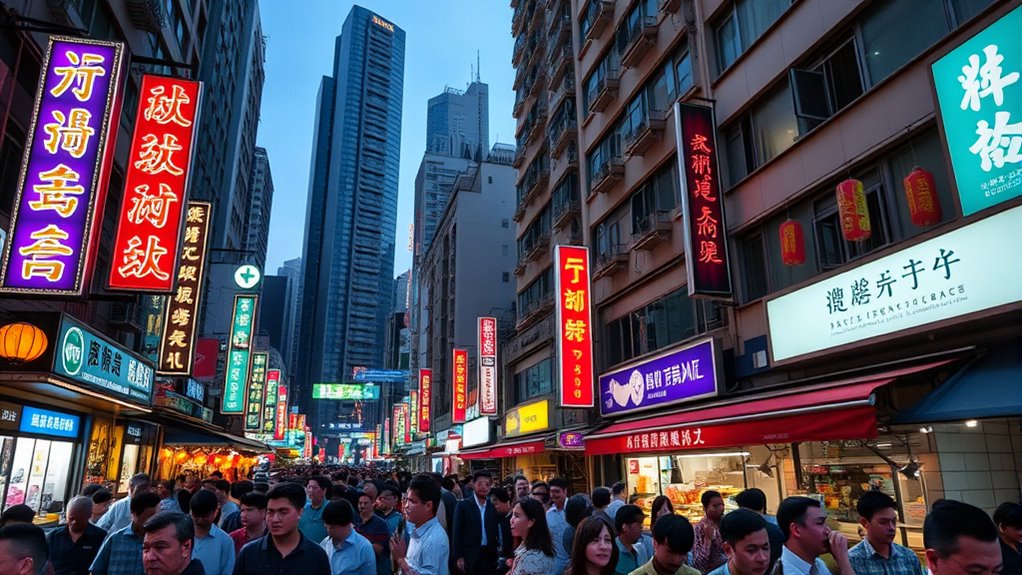
What defines Hong Kong’s contemporary cultural identity amidst rapid political and social changes? You see a unique blend of East and West, where traditional Chinese customs coexist with colonial influences and global trends. This hybridity shapes daily life, from local festivals to modern art, reflecting resilience and adaptability. Despite political tensions and the enforcement of the National Security Law, Hong Kong’s people continue to cherish freedoms, protest for democracy, and maintain a vibrant cultural scene. Social media and digital innovation foster new forms of expression, connecting generations. Yet, challenges remain—preserving heritage amid rapid urbanization, steering identity amid political shifts, and balancing economic strength with social cohesion. Incorporating cultural preservation strategies helps sustain the city’s diverse roots and adapt to change, ensuring that Hong Kong’s unique identity endures through evolving circumstances.
Frequently Asked Questions
How Did Hong Kong’s Early Economy Evolve Before British Colonization?
Before British colonization, your region’s economy was mainly based on farming, fishing, and salt production in small coastal villages. You relied on local resources and trade within Chinese empires, with artifacts showing prehistoric human activity. Portuguese traders set up a trading post in 1514, marking early foreign trade. By the 1800s, administrative divisions like Bao’an and Xin’an influenced local commerce, laying the groundwork for future economic growth.
What Role Did Hong Kong Play During the Taiping Rebellion?
Imagine Hong Kong as a quiet harbor catching whispers of chaos from the Taiping Rebellion. During this period, you see Hong Kong serving as a refuge, a safe haven for refugees fleeing the upheaval on the mainland. Its bustling port becomes a essential link, providing supplies and communication, subtly supporting both the Qing government and the fleeing populations, shaping its role as a key connector amid China’s internal strife.
How Did the Japanese Occupation Influence Hong Kong’s Cultural Landscape?
The Japanese occupation deeply impacted Hong Kong’s cultural landscape by disrupting daily life and fostering resilience among residents. You’d notice shifts in societal attitudes, with wartime hardships fostering a sense of unity and resourcefulness. Traditional customs were challenged, but local culture persisted, blending with new influences introduced during occupation. This period also left a legacy of collective memory, shaping Hong Kong’s identity and its ongoing dialogue about resilience and adaptation amid adversity.
What Specific Social Reforms Occurred During Hong Kong’s Post-War Industrialization?
During Hong Kong’s post-war industrialization, social reforms blossomed like a well-tended garden. You see, healthcare improved, making sure everyone had access to good medicine, and education expanded, opening doors for young minds to grow. Labor policies became fairer, giving workers a voice and better conditions. These changes helped transform Hong Kong into a thriving, vibrant city where people could dream bigger and build brighter futures together.
How Has the National Security Law Affected Hong Kong’s Cultural Expression?
The National Security Law has markedly impacted your cultural expression by imposing restrictions on protests, speeches, and artistic works that may challenge the government. You might feel limited in your freedom to express political views openly, leading to self-censorship. While Hong Kong still retains a vibrant cultural scene, the law creates an environment where you could be cautious about sharing or creating content that touches on sensitive topics, affecting the city’s dynamic cultural landscape.
Conclusion
So, here you are, marveling at Hong Kong’s vibrant history, from its humble beginnings to its modern chaos. You’ve seen its resilience, quirks, and the way it’s mastered the art of blending East and West—sometimes with more flair than sense. Just remember, in this city where tradition meets trend, you’re not just a visitor, but a tiny piece of its ongoing story. And honestly, that’s quite the cultural rollercoaster—buckle up!

